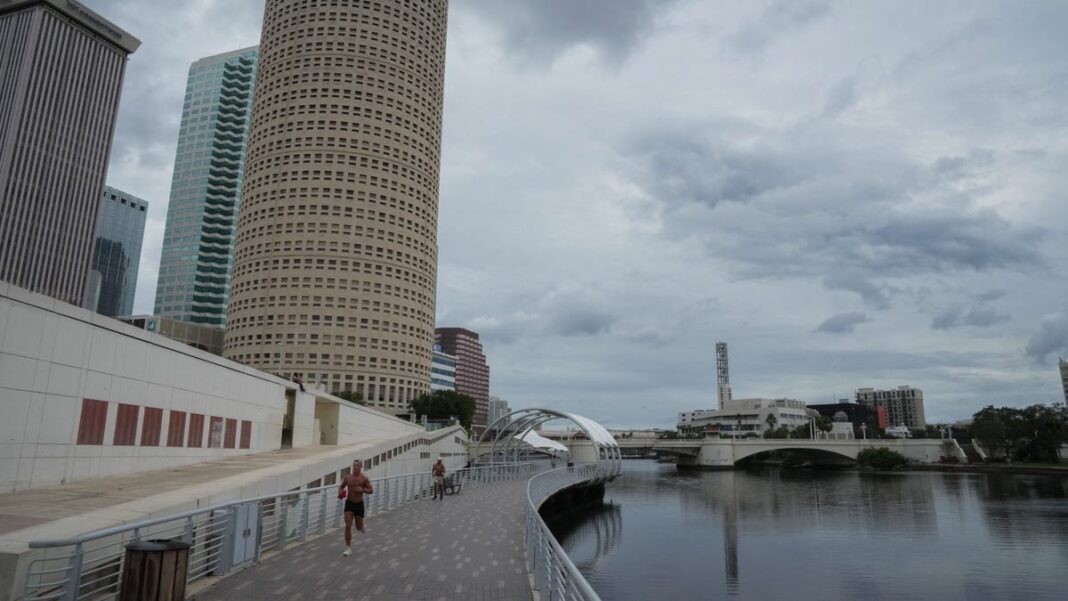Disaster scenario shows potential impact of Hurricane Milton on Tampa Bay
Four years back, a disaster preparation initiative named “Hurricane Phoenix” envisioned the worst possible outcomes of a hurricane striking Tampa. The projections bear a striking resemblance to the current forecasts as Hurricane Milton approaches the area.
The 2020 initiative conducted a simulation of a major hurricane, complete with dramatic, realistic video portrayals. The hypothetical “historic and catastrophic” Hurricane Phoenix made landfall in mid-October, unleashing winds of 160 miles per hour and gusts reaching 200 mph. The storm surge overwhelmed downtown Tampa, severing all bridges.
This training simulation was designed to assist emergency services, business owners, and others in contemplating the implications of a significant hurricane striking the city, as well as strategies for adequate preparation.
Currently, the forecast for Hurricane Milton is not as severe as what was predicted in the Hurricane Phoenix scenario, but it does carry warnings that resonate with the seriousness of that situation.
Impact of the fictional Hurricane Phoenix on Tampa
During the imagined event, the storm surge reaches the second floor of Tampa General Hospital, rendering it unable to accept new patients. St. Petersburg becomes isolated. Considerable wind damage extends deep inland.
The aftermath of the fictional hurricane reveals “unimaginable” destruction, with beaches nearly wiped out. The Howard Franklin Bridge, connecting St. Petersburg and Tampa, is completely obliterated. Businesses are devastated, and the entire region suffers massive setbacks.
Many structures sustain major damage, particularly roofs that are particularly susceptible to flying debris. Most high-rise buildings lose many of their windows.
Counties including Citrus, Hernando, Hillsborough, Manatee, Pasco, and Pinellas face life-threatening levels of rain, wind, and storm surge. Communication systems, television, and most radio stations are disabled. Important roadways become blocked with debris, hindering emergency response efforts.
As the tides rise, they reach heights of 9 to 12 feet above normal levels. The storm surges overtop barrier islands, sending vast amounts of water into Tampa Bay, potentially exceeding 20 feet above normal near St. Petersburg and 26 feet above the regular tide level by downtown Tampa. Areas well inland experience flooding via rivers and canals.
Between 27% and 43% of local fire stations, hospitals, police stations, and schools suffer damage, with many deemed inoperable.
There is speculation that MacDill Air Force Base may face permanent closure, and Port Tampa Bay, the fourth-largest port in Florida, might take three years to return to full operation.
Focusing on small businesses, the report suggests that soon after the hurricane, 40% of such businesses would close, and a year later, a quarter would remain shut. Within two years, 90% of affected small businesses could go out of business.
What does the forecast say for Hurricane Milton?
An October hurricane targeting Tampa Bay aligns with both the fictional Hurricane Phoenix scenario and the present circumstance as Milton approaches Florida.
However, the specific landfall point, strength, and consequences of Hurricane Milton remain uncertain, although forecasters caution that dire outcomes are still possible.
“Milton has the potential to be one of the most devastating hurricanes recorded in west-central Florida,” warned John Cangialosi, a specialist from the National Hurricane Center, in his Tuesday update. He emphasized that damaging winds, life-threatening storm surges, and heavy rainfall could extend far beyond the anticipated impact area.
Milton intensified rapidly on Monday, reaching sustained winds of up to 180 mph. As of Tuesday, it remained a Category 4 hurricane, but fluctuations in strength are expected as it approaches the coast. Landfall is predicted for late Wednesday as a Category 3 storm, but other outcomes are still viable.
Rainfall is expected to range from 5 to 12 inches, with certain localized areas potentially receiving up to 18 inches across central and northern Florida through Thursday.
Storm surge occurs when a tropical storm or hurricane drives water towards the coastline, leading to severe flooding along the shore, in bays, and inlets.
The National Hurricane Center has warned of “life-threatening” flooding risks. Peak storm surge predictions suggest heights of 10 to 15 feet for the entire Tampa Bay area.
Other disaster scenarios that predict severe consequences
Some planning scenarios have mirrored real disasters that occurred later. Meteorologists and hydrologists can foresee potential storm impacts, providing valuable data for local officials and emergency planners to effectively prepare, sometimes years ahead.
For instance, a year prior to Hurricane Katrina’s landfall, state and parish officials took part in a disaster simulation where a fictional Category 3 hurricane called “Pam” struck the New Orleans area.
This Hurricane Pam projection foreshadowed catastrophe. The hypothetical storm
Hurricane Katrina brought with it strong winds of up to 120 mph and delivered as much as 20 inches of rainfall to parts of Southeast Louisiana. The storm surge breached levees, leading to flooding in the New Orleans area. It was estimated that around 300,000 individuals did not evacuate before the storm hit, with predictions of 500,000 to 600,000 structures being destroyed. Essential services like phone and sewer systems were disrupted, and several chemical plants faced flooding.
In 2005, Hurricane Katrina struck New Orleans with winds reaching 125 mph.
The failure of levees resulted in flooding that engulfed various areas of the city, leaving thousands stranded on rooftops and in attics. Approximately 80% of New Orleans was submerged, with water levels rising to 20 feet, which devastated much of the city’s transportation and communication systems.
Even with mandatory evacuation orders in place, tens of thousands chose to stay behind, and up to 20,000 people sought shelter in the Superdome, known as the city’s “last resort refuge.”
Tragically, about 1,400 lives were lost during Hurricane Katrina and in the aftermath.

